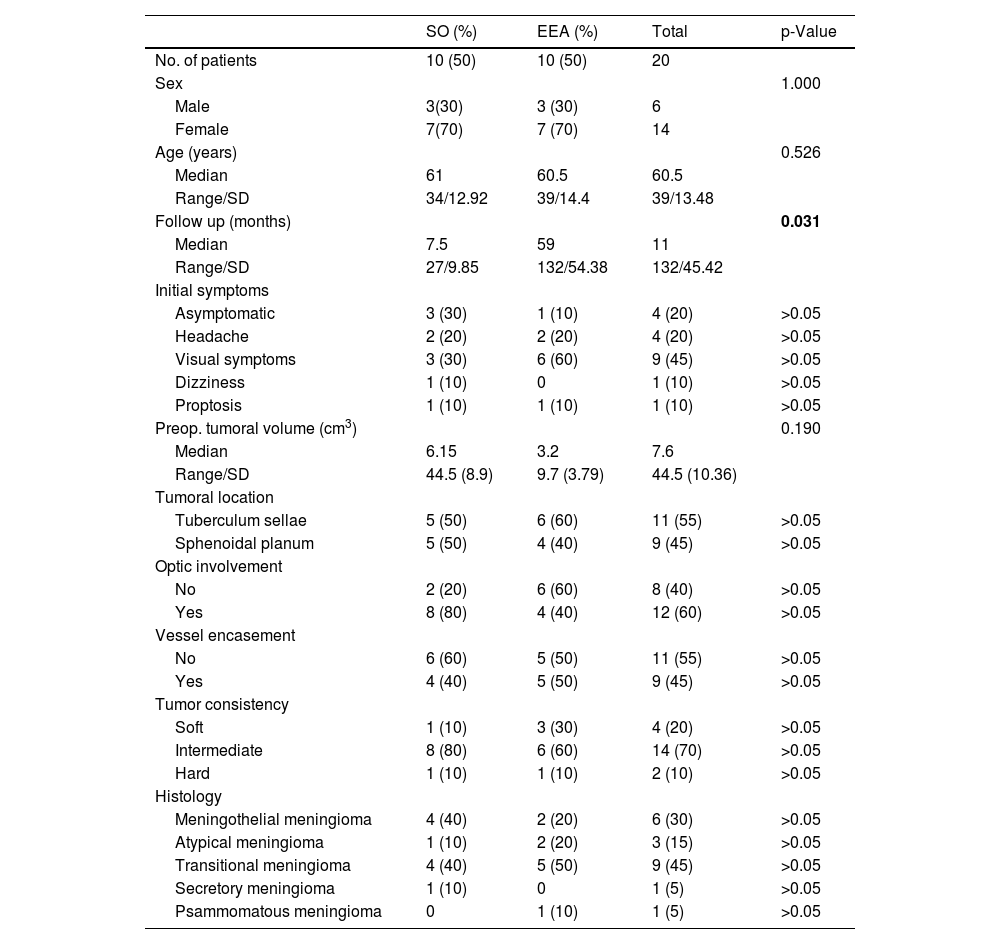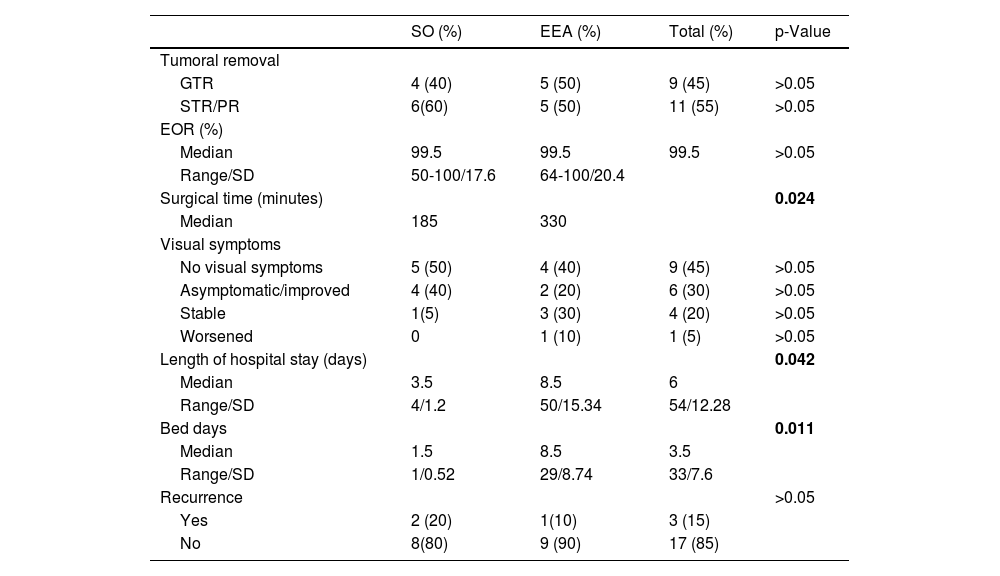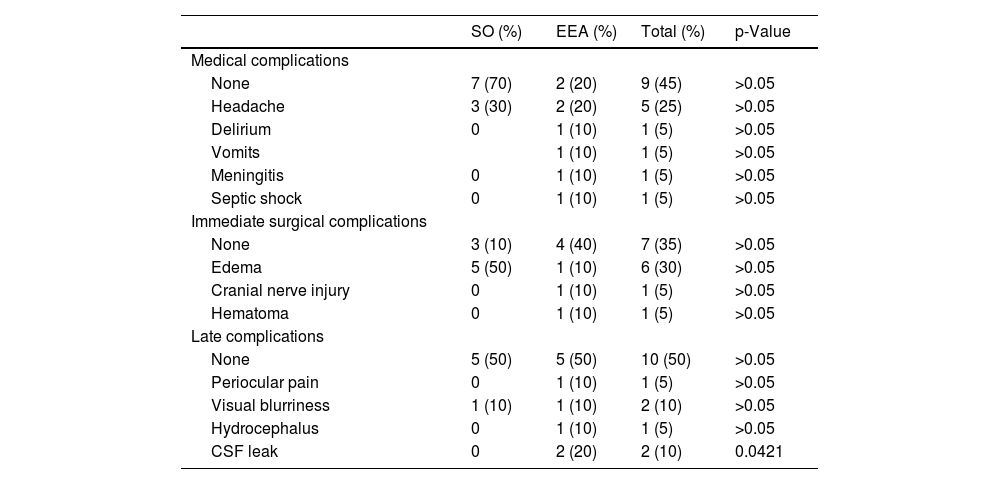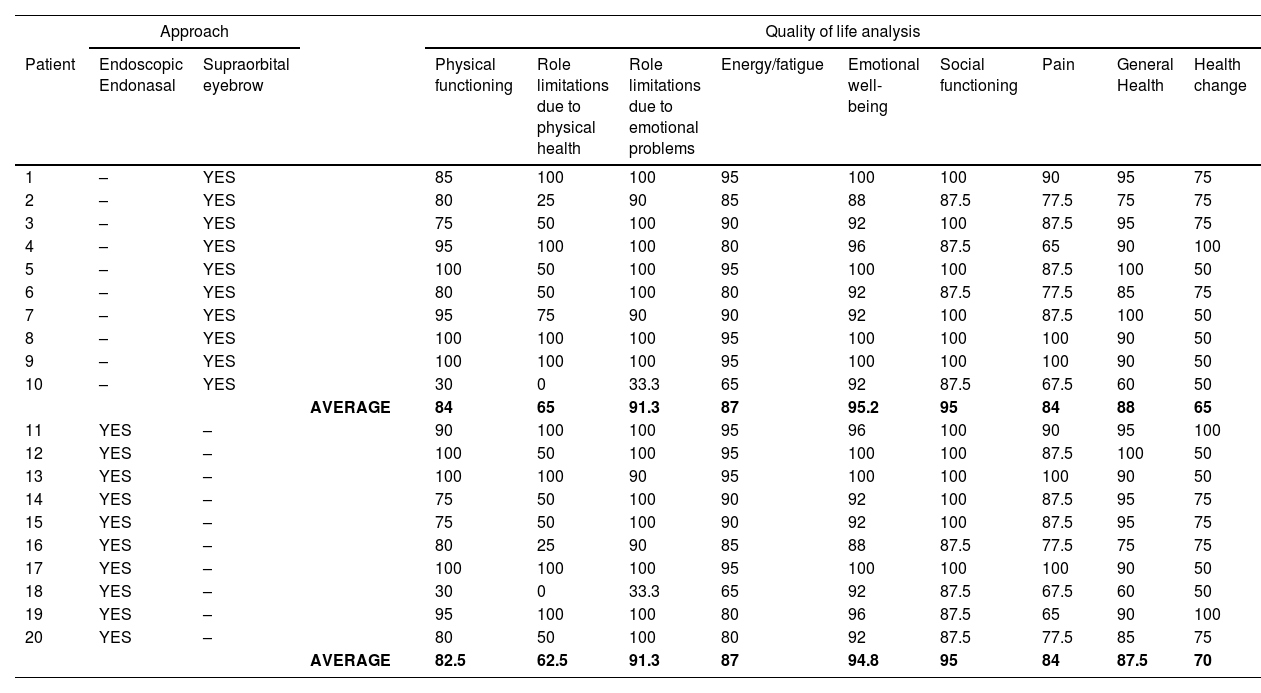In this prospective non-randomized study we reported our experience related to planum sphenoidale (PS) and tuberculum sellae (TS) meningiomas in a similar cohort of patients operated via the endonasal or the supraorbital route. A comprehensive quality of life analysis has been performed.
MethodsBeing comparable in general features, between November 2017 to January 2020, a total of 20 patients with anterior skull base meningioma were included. Hence, 10 patients were treated using the supraorbital keyhole procedure (SO) while 10 patients received an endoscopic endonasal approach (EEA). Both surgical techniques were analyzed and compared. Quality of life has been analyzed with the SF-36 questionnaire.
ResultsTwenty patients were identified who underwent either EEA (n=10) or SO (n=10). The average extent of resection achieved was not significantly different between the 2 groups. Post-operatively, the EEA group demonstrated a longer hospital stay and bed days compared with SO patients as well as a longer surgical time. There was a significant rate of more CSF leakage after EEA then after SO (20% vs 0%, p=0,0491). The follow-up period resulted shorter in the SO group, with a slight increased recurrence rate. Overall, no differences in visual outcome were detected. There were no differences in terms of quality of life between the two groups in all the explored items.
ConclusionsIn this single-center single-surgeon study of similarly sized and located PS and TS meningiomas, EEA showed longer hospital stays with higher degree of CSF leak compared with the SO group. Supraorbital craniotomy via eyebrow incision reported a comparable quality of life results, even if with a slightly higher percentage of recurrence and less follow-up.
En este estudio prospectivo no aleatorizado, informamos nuestra experiencia relacionada con los meningiomas del plano esfenoidal (PS) y la tuberculosis selar (TS) en una cohorte similar de pacientes operados por vía endonasal o supraorbitaria. Se ha realizado un análisis exhaustivo de la calidad de vida.
MétodosSiendo comparables en características generales, entre noviembre de 2017 a enero de 2020 se incluyeron un total de 20 pacientes con meningioma de base de cráneo anterior. Por lo tanto, 10 pacientes fueron tratados mediante el procedimiento de ojo de cerradura supraorbitario (SO), mientras que 10 pacientes recibieron un abordaje endonasal endoscópico (EEA). Se analizaron y compararon ambas técnicas quirúrgicas. La calidad de vida se ha analizado con el cuestionario SF-36.
ResultadosSe identificaron veinte pacientes que se sometieron a EEA (n=10) o SO (n=10). La extensión promedio de la resección lograda no fue significativamente diferente entre los 2 grupos. Después de la operación, el grupo EEA demostró una estadía hospitalaria y días de cama más largos en comparación con los pacientes SO, así como un tiempo quirúrgico más prolongado. Hubo una tasa significativa de más fistula de LCR después de EEA que después de SO (20% frente a 0%, p=0,0491). El período de seguimiento resultó más corto en el grupo SO, con una tasa de recurrencia ligeramente mayor. En general, no se detectaron diferencias en el resultado visual. No hubo diferencias en cuanto a la calidad de vida entre los dos grupos en todos los ítems explorados.
ConclusionesEn este estudio de un solo centro y un solo cirujano de meningiomas PS y TS de tamaño y ubicación similar, EEA mostró estancias hospitalarias más prolongadas con un mayor grado de fuga de LCR en comparación con el grupo SO. La craneotomía supraorbitaria a través de una incisión en la ceja reportó resultados de calidad de vida comparables, aunque con un porcentaje ligeramente mayor de recurrencia y menos seguimiento.
Article

If it is the first time you have accessed you can obtain your credentials by contacting Elsevier Spain in suscripciones@elsevier.com or by calling our Customer Service at902 88 87 40 if you are calling from Spain or at +34 932 418 800 (from 9 to 18h., GMT + 1) if you are calling outside of Spain.
If you already have your login data, please click here .
If you have forgotten your password you can you can recover it by clicking here and selecting the option ¿I have forgotten my password¿.













